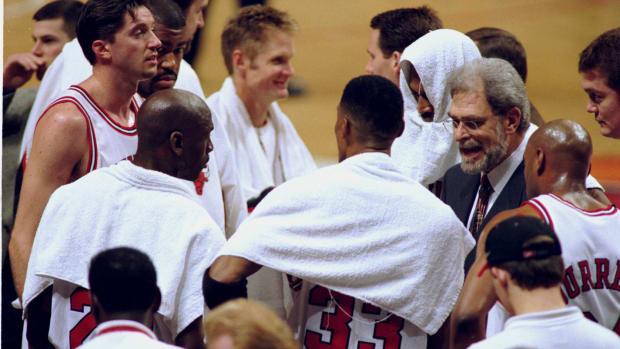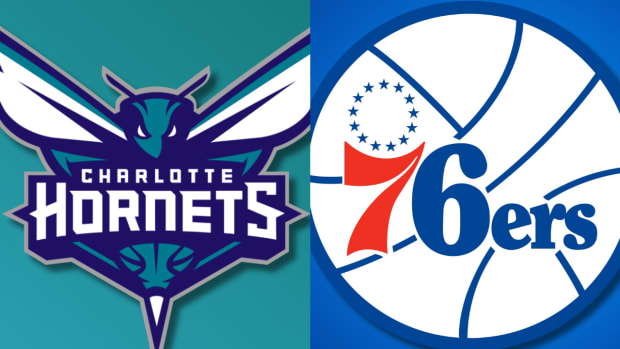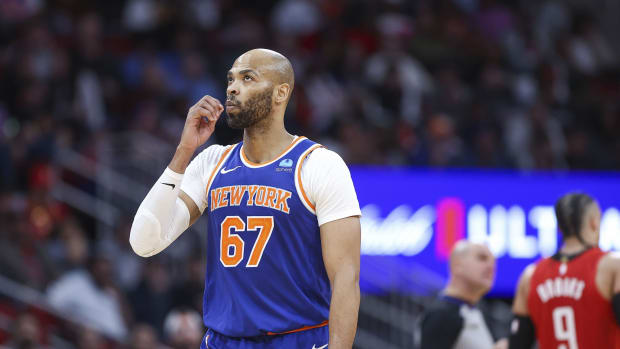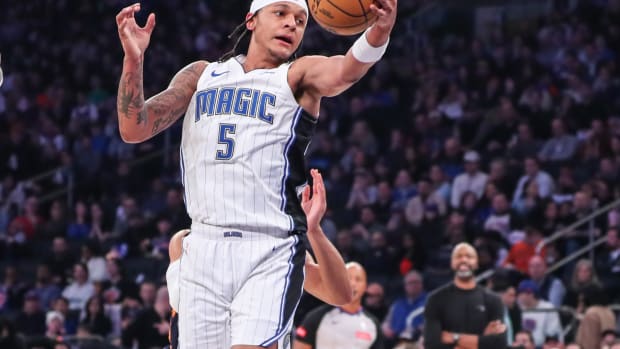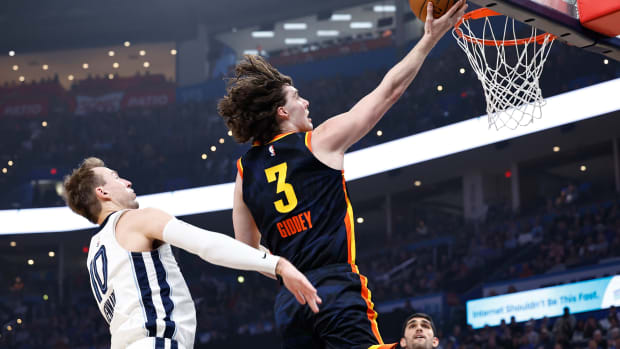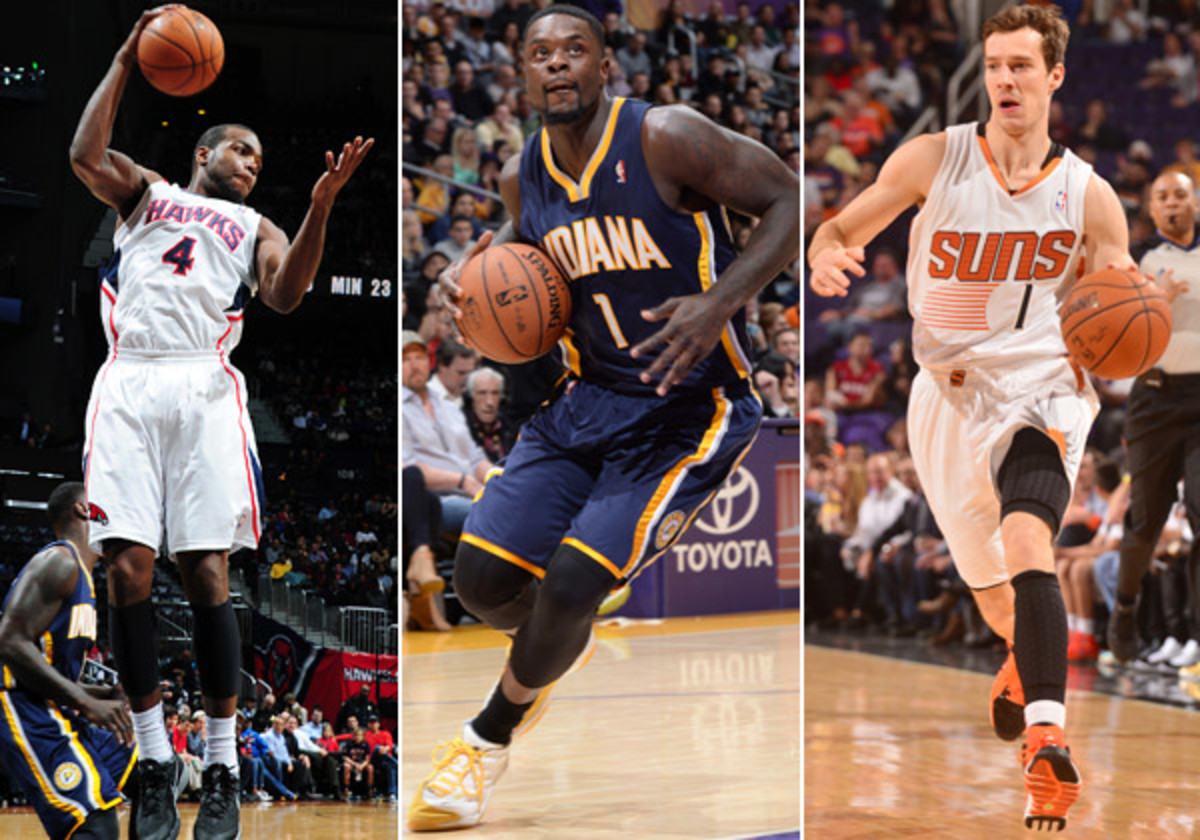
All-Gold Strike Team: Ten second-round picks who hit it big over the last decade
Paul Millsap (No. 47), Lance Stephenson (40) and Goran Dragic (45) were all second-round picks. (Getty Images)
"The Point Forward All-Stars" will have a new theme each week centered on a single shared trait that brings together the team members. This week, we take a look back at the last decade's worth of second-round picks.
Previously: The All-Grateful Team | The East's All-Letdown Team | The All-Atrocious Team | The All-Ignored Team | The All-Stocking Stuffer Team | The All-Recalibration Team | The All-Payday Team | The All-Gridiron Team | The All-Sanctioned Team | The All-Dunk Contest Team | The Non-Champions
Second-round picks, by definition, have always been the NBA's bridesmaid, and never the bride. Look no further than this year's All-Star Game, where a whopping six No. 1 overall picks (LeBron James, Dwight Howard, Blake Griffin, John Wall, Kyrie Irving and Anthony Davis) dominated the headlines and highlights, while Paul Millsap was the only second-round selection to compete in the game.
The bridesmaids were stuck watching Irving took home All-Star Game MVP honors, Griffin threaten the All-Star Game's scoring record with 38 points, and Wall winning the Slam Dunk Contest, but they would have their moment to shine just a few days later. Last week's trade deadline saw a total of zero first-round picks exchange hands, even though a slew of deals were consummated and a good chunk of the league's teams have been effectively eliminated from playoff contention. That left any asset-seeking architect of a rebuilding program to scrounge up the next best thing: second-round picks.
Nobody rolled up his khakis and dug into the muck quite like Sixers GM Sam Hinkie, who managed to acquire six second-round picks by participating in deals with the Clippers, Pacers, Cavaliers, and a three-team deal with the Nuggets and Wizards. Of course, those picks were simply added to a stockpile of draft considerations that Hinkie began compiling as soon as he took over in Philadelphia last summer.
We all know the example of Manu Ginobili -- three-time champion, two-time All-Star, future Hall of Famer -- who was miraculously plucked by the Spurs with the No. 57 pick in the 1999 draft, but we also know that he is clearly the exception and not the rule when it comes to second-round pick performance. What exactly are the odds facing Hinkie and his colleagues when it comes to finding contributors in the second round? And who exactly, besides Ginobili, has emerged as second-round gold strikes in recent years? Let's take a look.
(All statistics are through Feb. 25.)
Surveying Second-Round Picks
The Point Forward analyzed the 300 second-round picks made between 2004 and 2013, charting players by asking the following questions:
- Did they succeed in making the NBA?
- How many minutes did they log and how many years of experience did they accrue?
- What were their average Efficiency Rating (PER) during their NBA career and how many total Win Shares did they accumulate along the way?
The survey confirmed many of the widely-held notions of how difficult it is to hit pay dirt in the second round, while also quantifying how difficult it is to find talent there. The following are five takeaways from this examination:
1. The washout rate is very high. Many second-round picks never actually realize their dreams of competing in an NBA game. In fact, nearly one-third of the second-round picks made in the last 10 years (98 out of 300) have not played in the NBA.
Even making it to Year Two can prove difficult. Of the 270 second-round picks taken from 2004 to 2012 -- in other words, the guys in our 300-player sample who could have played for at least two years -- only 141 have two or more years of experience. Roughly speaking, that means a player selected in the 2014 second round can be expected to have just slightly better than a 50/50 shot of playing two NBA seasons, whether they happen immediately upon selection or at some point down the line.
Of those who do find a way to stick, many move on before they can get truly comfortable (or cash in with a new contract). The average career length of all second-round pick taken from 2004 to 2008 -- including those who never made the league -- was 2.7 years. That number rose to 3.8 years among second-round picks who appeared in at least one NBA game, a figure that's still below the NBA's overall average career length of 4.8 years.
Consider this for context: an NBA player who averages 25 minutes a night and appears in 70 games will log roughly 1,750 minutes over the course of a season. Of the 180 second-round picks taken between 2004 and 2009, only 55 have played at least 1,750 minutes over their entire careers. In other words, less than one-in-three second-round picks over a six-year period have managed to hang on for what we would consider a single season's worth of decent playing time.
Stars like Carlos Boozer and Nikola Pekovic are rare in the second round. (David Sherman/NBAE/Getty Images)
2. Don't expect a star. While GMs make memorable mistakes all the time (Greg Oden over Kevin Durant, Jonny Flynn over Stephen Curry, etc.), the collective group of 30 executives and their scouting staffs don't often completely miss on a budding A-list talent. The last 10 drafts have produced exactly two second-round picks who went on to earn All-Star selections -- Marc Gasol and Millsap -- and zero players who have earned multiple All-Star selections.
Indeed, of the 76 players who have made an All-Star team between 2005 and 2014, only eight were second-round picks (Ginobili, Millsap, Gasol, Carlos Boozer, Mo Williams, Rashard Lewis, Gilbert Arenas and Mehmet Okur). One other All-Star (Ben Wallace) went undrafted. Who made up the rest of the All-Stars? A jaw-dropping 53 lottery picks and 14 non-lottery first-round selections. To underline this point, Lakers guard Kobe Bryant has more All-Star Game selections over the last decade (10) than all currently-active second-round picks combined (Ginobili, Millsap, Gasol, Boozer, Williams and Lewis combine for 9).
One might argue that an All-Star selection can be a self-fulfilling prophecy, as players with greater name recognition -- a quality boosted by a spot in the lottery or high-level performance in high school and college -- have a built-in advantage over second-round talents. One recent example: Goran Dragic, a second-round pick, was passed over for an All-Star spot this season by lottery picks like Davis and Damian Lillard.
It's a fair point, but any such snubbing seems to be happening on the margins. The second-round picks who have maintained the highest average PER for multiple seasons include Nikola Pekovic (19.2), Millsap (18.9), Isaiah Thomas (18.8), Gasol (18) and Lou Williams (17.1); all are quality players but none can really claim to have been habitually overlooked in favor of less-deserving, higher-profile players. Further, Gasol is the only active second-round pick who can really be regarded as a superstar caliber player right now.
3. Finding immediate-impact contributors isn't easy. Hoping that your tanking team will be able to plug-and-play second-round picks into the rotation for a quick turnaround next season? It's probably smart to pump the brakes on that idea. Entering Tuesday's action, the 30 second-round picks from the 2013 draft had averaged just 93.7 minutes played for their entire rookie seasons.
That number, which breaks down to less than two minutes per game to date, actually overstates the impact of this year's second-round class. Sixteen 2013 second-round picks have yet to take the court this season and only seven players from this group have managed to log at least 100 minutes. Some of that can be explained by teams drafting international players and stashing them overseas, but talent and readiness are major factors, too.
This year's top minutes-earners -- Nate Wolters, Ryan Kelly, and Lorenzo Brown -- are all plying their trades for truly bad teams, and it's fair to say that there are zero 2013 second-round picks who have made a real impact for playoff-bound squads this season. Year Two is, as you would expect, more promising: Seven 2012 second-round picks -- Jeff Taylor, Jae Crowder, Draymond Green, Khris Middleton, Will Barton, Mike Scott and Kyle O'Quinn -- have all already logged at least 1,000 career minutes and have shown varied degrees of potential in doing so.
There are only so many ways you can write "keep your expectations in check" without getting redundant. Here's one final note for the road: Of the 150 second-round picks from 2009 through 2013, just four have so far proven to be strong, dependable starters and/or standout postseason performers: Chandler Parsons, Thomas, Lance Stephenson, and Danny Green. There are a host of other capable rotation players -- Scott, Green, Patrick Beverley, DeJuan Blair, Marcus Thornton, Kyle Singler, Dante Cunningham, and Chase Budinger, among others -- but the last five years worth of drafts have produced about one solid gold strike per year, if that.
Not only did Vladimir Veremeenko never play in the NBA, but he never got a real jersey. (Jennifer Pottheiser/Getty Images)
4. The pickings get even slimmer after pick 45. The bottom half of the second round is a who's who of hard-to-pronounce names who have left little impact on the NBA. Remember that time Vladimir Veremeenko (No. 48 in 2006) exploded for 35 against the Lakers? Or, when Izzet Turkyilmaz (No. 50 in 2012) messed around and got a triple-double? Or, when Chukwudiebere Maduabum (No. 56 in 2011) and Tanguy Ngombo (taken one spot after Maduabum) traded buckets down the stretch at Madison Square Garden? Of course not. None of those things happened because none of those guys has ever sniffed the league.
All told, 71 of the 150 players selected from spots 46 to 60 over the last 10 years have never played in a single NBA game. Only 10 players taken in this range -- Millsap, Gasol, Amir Johnson, Marcin Gortat, Ramon Sessions, Ryan Gomes, Andray Blatche, Thomas and Green -- have compiled at least 10 career Win Shares. That's a marked difference from the top half of the second round, where only 27 of the 150 players selected from 31 to 45 have failed to appear in the NBA, and where 30 players (including the likes of Anderson Varejao, Monta Ellis, Williams, Dragic, and Parsons) have compiled at least 10 career Win Shares.
The takeaway: hitting pay dirt with the likes of Millsap (No. 47 in 2006), Gasol (No. 48 in 2007) and Thomas (No. 60 in 2011) can happen even as draft night drags into its closing stages, but the bust rate increases considerably along the way.
5. Don't draft any one named "Ricky" in the second round. Just don't do it! The four players named Ricky (the Rickies?) drafted in the second round over the last decade -- Ledo (2013), Minard (2004), Paulding (2004) and Sanchez (2005) -- have combined to play just 33 minutes total. Although no name has been truly foolproof, "Ryan" has been solid: Gomes (2005), Hollins (2006), Kelly (2013), Reid (2010) and Richards (2010) have combined to play more than 19,000 minutes over 18 seasons.
Staying away from "Sergei" and the alternate spelling of "Sergiy" is smart, too, as Karaulov (2004), Lishouk (2004) and Gladyr (2009) all failed to make it to the league.
The Clippers found the rarest of assets in the second round: a franchise center. (Nathaniel S. Butler/NBAE/Getty Images)
The Point Forward's All-Gold Strike Team
Here's a look at The Point Forward's top 10 second-round picks from the last 10 drafts, a subjective ranking that attempts to balance current ability, overall career performance, awards and honors, advanced statistical production, and draft position (small bonus points given for later picks).
10. Amir Johnson (No. 56 in 2005)
The Raptors' forward is a quintessential second-round hit in that he's usually overlooked even in discussions of the "most overlooked" players. A modest 7.2 career scoring average can have that effect, but Johnson's defensive ability, screen-setting skills and general awareness have cultivated a cult following among NBA geeks. Detroit selected him straight out of high school and his playing time ramped up slowly over his first four seasons. A change of scenery in 2009 opened up new possibilities for Johnson, 26, who has been used as both a starter and a big minutes reserve over the last four years in Toronto. He secured a five-year, $30 million contract in 2010 and has delivered by averaging 10.3 points and 6.6 rebounds for the Atlantic Division-leading Raptors. His 32.2 career Win Shares rank fourth among the 300 players taken in the second round since 2004.
Johnson got the nod for the final spot over the likes of Anderson Varejao, Trevor Ariza, Carl Landry, Brandon Bass, Marcin Gortat and Mario Chalmers.
9. DeAndre Jordan (No. 35 in 2008)
The second round is all about taking fliers and the Clippers' decision to take one on Jordan has looked better and better by the year. Although his free throw shooting is ghastly and his ability to captain a defense still needs some work, the 25-year-old Jordan has made major strides since he entered the NBA after going one-and-done at Texas A&M. The 6-foot-11 alley-oop finishing machine hasn't missed a game in three seasons, and he's averaging a career-best 10.2 points and a league-leading 14 rebounds per game this season. Jordan understands his limitations and knows how to exploit his athletic advantages, two reasons why he's shot better than 60 percent for six straight years. Will he ever fully realize his insane physical gifts? Who knows, but he's already earned a four-year, $43 million contract in 2011.
8. Nikola Pekovic (No. 31 in 2008)
Effectively pulling off the draft-and-stash approach requires patience, luck and timing, not to mention a player who is skilled enough to successfully make the transition from the international game to the NBA. It took two full seasons after the 2008 draft for Pekovic, 28, to make his NBA debut and it took another season for him to truly get his bearings. The waiting has paid off, though, as the burly Montenegrin center has evolved into a low-post force capable of averaging 18 points and 9.1 rebounds per game this season. Coming to America has been worth Pekovic's while too: he cashed in with a five-year, $60 million contract last summer, thanks in part to his elite offensive rebounding which is now among the league's best for a third straight season. His average PER of 19.2 is tops among second-round picks from the last 10 years who have played at least two seasons.
7. Isaiah Thomas (No. 60 in 2011)
There was no mystery why Thomas, 25, slipped all the way to the last pick in the 2011 draft after three strong seasons at Washington. Passed over because of his 5-foot-9 height, Thomas has enjoyed a breakout 2013-14 season, as he ranks No. 4 among all point guards in PER. A smooth scorer with three-point range, Thomas is putting up 20.6 points and 6.3 assists for the Kings, who shipped out Greivis Vasquez in December and made him the full-time starter. Although his overall impact will always be curtailed by his defensive limitations, Thomas is in position to cash in on his scoring ability as soon as the summer free agency period hits. Given his draft position, he could go down as one of the greatest second-rounds steals of all time if he is able to continue piling up points in bunches throughout his prime.
6. Lance Stephenson (No. 40 in 2010)
One of this year's leading All-Star snubs, Stephenson's NBA journey began with a rocky start, as off-court issues killed his draft stock and limited his playing time over his first two seasons. Stepping into a starting role last year, Stephenson began to find a way to harness the athletic gifts that earned him his "Born Ready" moniker, and this season he's taken his all-around game to another level. He's averaging career-highs across the board -- 14.2 points, 7.3 rebounds, and 5.2 assists -- while handling more play-making duties on offense and evolving into an absolute menace on defense. A strong candidate for the 2014 Most Improved Player award, the 23-year-old Stephenson should be in line for a large payday this summer.
You might not love his shot selection, but Monta Ellis was an all-time second-round steal. (Glenn James/NBAE/Getty Images)
5. Monta Ellis (No. 40 in 2005)
You can certainly argue that the polarizing Ellis wasn't worth the six-year, $66 million contract he signed in 2008 or even the three-year, $25.1 million contract he signed last summer, but you can't dispute that he has been a home run as far as second-round picks go. Drafted straight out of high school prior to the implementation of the one-and-done rule, Ellis averaged at least 19 points for five straight seasons with the Warriors and Bucks. Best known for his love of shooting, as he peaked at an absurd 22 field goal attempts per game in 2010, Ellis has proven to be a nice fit with the Mavericks, who have taken advantage of his comfort in pick-and-roll situations. If there's one thing that Ellis doesn't get enough credit for, it's his ability to handle gigantic workloads year after year: his 20,000+ career minutes is 3,000+ more than any other player taken in the second round from 2004 to 2013, totally outpacing the likes of Millsap, Gasol and Ariza.
4. Goran Dragic (No. 45 in 2008)
Sometimes second-round gold can look like pyrite for years. The Slovenian point guard saw more than his fair share of turbulence early in his career, as he spent two-plus seasons playing limited minutes for the Suns, who acquired his draft rights in a trade with the Spurs. Phoenix actually gave up on him in 2011, shipping him to Houston with a first-round pick for Aaron Brooks. Dragic established himself as a starting quality player in 2011-12 with the Rockets, but that progress wasn't rewarded by Houston's management, who instead successfully pursued Jeremy Lin in restricted free agency. Dragic ultimately signed a handsome four-year, $30 million contract to return to Phoenix, where he was tasked with heading up the post-Steve Nash transition. Things have gone swimmingly this season: The 27-year-old Dragic put himself in contention for an All-Star spot by averaging 20.3 points and 5.2 assists for the surprising Suns, who are tracking towards a playoff spot under first-year coach Jeff Hornacek.
3. Chandler Parsons (No. 38 in 2011)
If there was a single blueprint for the ideal second-round pick, Parsons just might be the guy. Not only did he arrive in the league ready to contribute after spending four years at Florida, the small forward has shown steady progress over the course of his three-year career. A perfect fit in Houston's three-point happy system, Parsons is averaging a career-high 17.1 points, 5.6 rebounds and 3.7 assists while shooting 39.6 percent from deep. He's proven to be very reliable despite playing huge minutes both this season and last, and he even went above and beyond to help recruit an A-list franchise center in Dwight Howard. As if that combination of production, fit, durability and team-first personality wasn't enough, Parsons is also one of the league's very best values, thanks to the ingenious four-year, $3.6 million contract the Rockets inked him to in 2011. If he continues to progress at his current rate, the 25-year-old Parsons could soon find himself in the discussion for an All-Star spot, even if he's clearly Houston's third wheel behind Howard and James Harden. His 5.5 Win Shares per year trails only Gasol and Millsap among the last 10 years worth of second-round picks.
2. Paul Millsap (No. 47 in 2006)
It took awhile for the Louisiana Tech product to hear his name called on draft night in 2006, but he wasted no time at all making an impact for Jerry Sloan's Jazz. The durable Millsap missed just six games total over his first three years, and he parlayed that durability and a versatile inside/outside game into a four-year, $32 million offer sheet from the Blazers in 2009. Appreciating Millsap's game and wanting to keep him in the fold with a team that made the playoffs in each of his first three seasons, Utah matched and retained his rights, eventually pairing him with Al Jefferson to lead the post-Deron Williams Jazz. After that duo ran its course, the Hawks capitalized on Utah's rebuilding plans by signing Millsap, 29, to a bargain basement two-year, $19 million contract last summer. He promptly delivered the first All-Star appearance of his career while averaging a career-high 17.6 points, 8.3 rebounds and 3 assists per game. Millsap's 52.9 career Win Shares are tops among the 300 second-round picks selected over the last 10 years.
1. Marc Gasol (No. 48 in 2007)



































